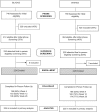Factors That Explain Differences in Abstinence Between Black and White Smokers: A Prospective Intervention Study
- PMID: 30657926
- PMCID: PMC6792072
- DOI: 10.1093/jnci/djz001
Factors That Explain Differences in Abstinence Between Black and White Smokers: A Prospective Intervention Study
Abstract
Background: Black-white differences in smoking abstinence are not well understood. This trial sought to confirm previously reported differences in quitting between blacks and whites and to identify factors underlying this difference.
Methods: During enrollment, 224 black and 225 white low-income smokers were stratified on race and within race on age and sex to ensure balance on these factors known to impact abstinence. The intervention included varenicline for 12 weeks and six guideline-based smoking cessation counseling sessions. The primary endpoint was cotinine-verified 7-day point prevalence smoking abstinence at week 26. A priori socioeconomic, smoking, treatment process (eg, treatment utilization, side effects, withdrawal relief), psychosocial, and biological factors were assessed to investigate race differences in abstinence. Unadjusted odds ratios (OR) were used to compare abstinence between blacks and whites. Adjusted odds ratios from logistic regression models were used to examine predictors of abstinence. All statistical tests were two-sided.
Results: Blacks were less likely to achieve abstinence at week 26 (14.3% vs 24.4%, OR = 0.51, 95% confidence interval [CI] = 0.32 to 0.83, P = .007). Utilizing best subsets logistic regression, five factors associated with race jointly predicted abstinence: home ownership (yes/no, OR = 3.03, 95% CI = 1.72 to 5.35, P < .001), study visits completed (range = 0-6, OR = 2.81, 95% CI = 1.88 to 4.20, P < .001), income (household member/$1000, OR = 1.03, 95% CI = 1.01 to 1.06, P = .02), plasma cotinine (per 1 ng/mL, OR = 0.997, 95% CI = 0.994 to 0.999, P = .002), and neighborhood problems (range = 10-30, OR = 0.88, 95% CI = 0.81 to 0.96, P = .003).
Conclusions: The race difference in abstinence was fully explained by lack of home ownership, lower income, greater neighborhood problems, higher baseline cotinine, and higher visit completion, which were disproportionately represented among blacks. Findings illuminate factors that make it harder for blacks in the United States to quit smoking relative to whites and provide important areas for future studies to reduce tobacco-related health disparities.
Trial registration: ClinicalTrials.gov NCT01836276.
© The Author, 2019. Published by Oxford University Press. All rights reserved. For permissions, please email: journals.permissions@oup.com.
References
-
- US Department of Health and Human Services. The Health Consequences of Smoking–50 Years of Progress. A Report of the Surgeon General. Atlanta, GA: US Department of Health and Human Services, Centers for Disease Control and Prevention; 2014.
-
- Jamal A, King BA, Neff LJ et al. . Current cigarette smoking among adults - United States, 2005–2015. MMWR Morb Mortal Wkly Rep. 2016;6544:1205–1211. - PubMed
-
- US National Cancer Institute. A socioecological approach to addressing tobacco related health disparities. In: National Cancer Institute Tobacco Control Monograph 22. NIH Publication No. 17-CA-8035A. Bethesda, MD: US Department of Health and Human Services, National Institutes of Health, National Cancer Institute; 2017.


